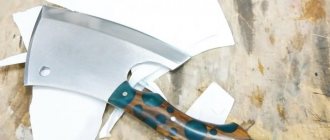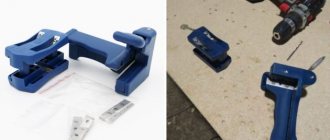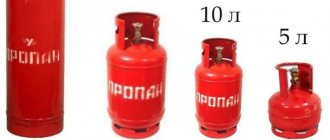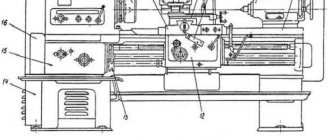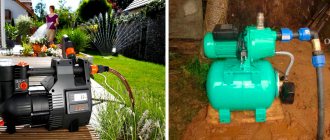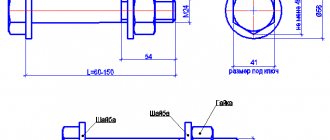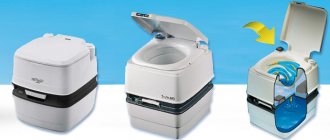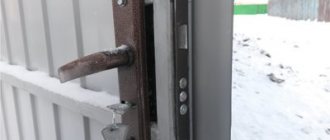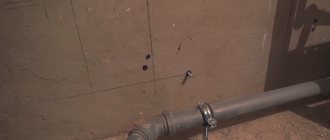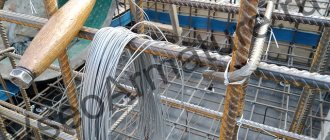A furniture bolt is a connecting element used in the creation of furniture made of natural wood, slabs, fiberboard, as well as during construction work. On the territory of the Russian Federation and the countries of the former USSR they are issued based on the requirements of two State standards. The first designates the geometry and production requirements for bolts with square carriage heads, the second - fasteners with mustaches and semicircular enlarged heads. The Russian standard corresponds to the German Din 603.
No. 1. Distinctive features of furniture bolts
The bolt is one of the most common fasteners. Everyone knows that it consists of a head and a cylindrical rod. The rod has a thread onto which a nut is screwed. The most common construction bolts have a hexagonal head and are used both in private construction and in the construction of industrial facilities. There are also particularly strong machine-building and road bolts, plowshare bolts with countersunk heads (used in agriculture), as well as rarer railway and elevator bolts.
A furniture bolt even looks different from a regular construction bolt . First of all, it is “given away” by its semicircular hat. The rod may be fully or partially threaded. Below the head is a mustache or carriage . This element is necessary so that when tightening the nut, the bolt does not turn and the fastening does not loosen. The headrest or bracket rests against the wood piece of the furniture and prevents unnecessary rotation.
Furniture bolt with mustache
The semicircular head, due to the absence of sharp edges and any protrusions, ensures maximum safety for the operation of furniture with such fasteners. It is impossible to catch on a furniture bolt; it does not spoil the appearance of the product, since after installation only the smooth surface of the head will rise above the part. Such bolts are found in every modern chair, sofa and bed.
For production, mainly stainless steel with galvanized coating is used. Less common are bolts made of hard plastics and aluminum. In terms of strength, furniture bolts are inferior, for example, to engineering bolts, but they are also several times cheaper. Yes, there is not such a strong load on furniture fasteners, but this does not mean that you can buy the first bolts you come across. It is better to check with the seller for a certificate of conformity and quality - this is a guarantee that the fasteners made will be reliable and durable. The Rusmetiz store sells high-quality and certified products: furniture bolts presented on the page https://rus-metiz.com/categories/bolty are sold in different sizes, and if difficulties arise with the choice, specialists will always give qualified advice.
Furniture bolt with headrest
Varieties
One of the most commonly used fastening hardware is a simple bolt - this is a small pin, which has a uniform thread along its entire length, and is crowned with a hex head at one end. A pinch bolt is used to securely connect multiple parts of a product as it secures them tightly with a nut. Screws may vary in design, shape, strength class, area of use, material or size.
By design
When choosing the right fastening, much attention is paid to its design, since it is this that affects the reliability of the connection and the aesthetics of the piece of furniture as a whole. There are three main varieties:
- Threaded - such hardware has a thin, narrow cut into parts of a wide pin, to which a driven nut goes in pair, and the cap is a large, thick hexagon. The thread can be located along the entire length of the rod, or maybe only on a small part of it. Usually they are completely hidden - this adds aesthetics to the furniture. Threaded dowels are used for assembling chairs and sofas, since their main advantage is high reliability. Among the disadvantages, one can note the difficulty of use, because special holes must first be made.
- Confirmat - this Eurobolt is very similar in appearance to a screw. It is the most common mount. The long thin rod is covered with wide threads along its entire length, and the head has internal hexagon holes. Used when assembling cabinet furniture, since the pin must be completely hidden inside the cabinet. Eurobolts have the main advantage - they are quickly installed and provide tight adhesion to the material.
- An eccentric coupler is a so-called invisible fastener, which consists of an eccentric (clamp), a rod with a head and a separate plug located inside a blind hole. An eccentric is placed inside, where it is tightly fixed, completely hidden from view. Used for fastening elements of tables, cabinets, bedside tables and other cabinet furniture. The advantage is complete secrecy, as well as the possibility of reuse, but the disadvantages include the difficulty of installation at home.
No. 2. Scope of application of furniture bolts
Where else could furniture bolts be used if not in the furniture industry? That's right. The main purpose of this fastener is to connect furniture parts, but the convenient design with a semicircular head was highly appreciated by builders and began to be used in other areas.
Currently, furniture bolts are used for the following purposes:
- in the production of tables, chairs, sofas, beds, cabinets, chests of drawers, kitchen sets and other furniture;
- when repairing furniture, when replacing old bolts is required. By the way, when moving, furniture can be disassembled by unscrewing some of the fasteners, and assembled in a new place using existing bolts, because they are not disposable;
- for connecting wooden parts in private construction and repair, for example, when creating stairs and gazebos;
- in some other areas (mechanical engineering, road work, bridge construction, door lock production), when it is necessary that the height of the cap be minimal, and the area itself is not responsible.
No. 3. Manufacturing standards and size of furniture bolts
A high-quality furniture bolt is one that is produced in full compliance with the standard. It remains to figure out what kind of standards are used, because there are several of them:
- GOST 7801-81 is devoted to bolts with a mustache and an enlarged semicircular head. According to it, bolts with threads with a cross-section from 6 to 20 mm are produced (marked M6-M20 ). The height of the head ranges from 3 mm for M6 to 10 mm for M20, the cross section of the head is from 14 to 44 mm, respectively. The length of the bolt can be from 25 to 200 mm, the length of the thread - from 18 to 46 mm, the height of the mustache - from 3 to 9 mm. This standard does not produce bolts of certain lengths. The weight of 1000 pieces of the smallest bolts (M6, length 25 mm) is 6.5 kg, and the largest (M20, length 200 mm) is 484.3 kg;
- GOST 7802-81 regulates the geometry of carriage bolts. The thread cross-section of such bolts ranges from 5 to 24 mm (M5-M24), and the head cross-section ranges from 11 to 52 mm. Depending on the size, the height of the head is 2.5-12 mm, the headrest is from 3 to 15 mm, the size of the headrest on each side is from 5 to 24 mm. Thread length is from 16 to 60 mm, the length of the entire fastener is 12-260 mm. The weight of the smallest bolts is 2.7 kg/1000 pieces, the largest - 911 kg/1000 pieces.
- DIN 603 is a German standard, an analogue of our GOST 7802-81, but in some respects it differs slightly from it. The standard allows the production of M6-M8 bolts from hard plastics; for M10-M20 bolts it is necessary to use stainless steel (A4 or A2), as well as brass compositions. Standard bolts receive a head with a diameter of 12.45-46.8 mm and a height of 2.7-11.05 mm. The height of the headrest is 2.9-14.1 mm, the length of the thread is 16-65 mm, the length of the fastener is 16-200 mm, the headrest protrudes 4.52-20.84 mm on each side. The weight of 1000 pieces of products is from 4 to 597 kg.
It is better to look for the exact dimensions that a particular fastener should have in official standards and, when purchasing, be guided by these indicators. Nuts are selected according to the size of the bolt.
Do not confuse furniture bolts with furniture screws . The latter receive a hexagonal head, which during installation is completely recessed into the product. Screws are produced according to DIN 912 and our standard 11738.
No. 4. Furniture bolt material
We have already touched on this topic indirectly, considering various standards, but now we will consider it in more detail. Previously, furniture bolts were made of metal that was not protected from corrosion. Even if the humidity level in the room in use is normal and rivers do not flow, the fastening still begins to rust over time. It's all due to natural humidity. Not only does such hardware gradually lose strength, but if it is necessary to disassemble a piece of furniture and remove a nut from a bolt, difficulties arise - it tightly “clings” to the thread, and removing it, especially in a hard-to-reach place, is almost impossible. This problem has long been eliminated - today’s bolts do not corrode, as they are made from the following materials:
- stainless steel with a galvanized white or yellow coating; bolts with additional chrome plating are less common;
- brass and copper bolts are less common and cost more;
- hard plastics.
The vast majority of furniture bolts are made of galvanized stainless steel. In the marking, the manufacturer must indicate the steel grade used:
- A2 (domestic analogue - 08Х18Н10) - an excellent material that is not subject to corrosion, is almost non-magnetic, and can withstand temperatures from -200 to +4250C;
- A4 steel (10Х17Н13М2) contains 2-3% molybdenum, making it even more resistant to moisture and acids, so fasteners made from this material are used even in aggressive environments. Bolts of class A accuracy are made from steel class A2 and A4 (more on this below);
- Other types of steels are also used in production, for example, 38KhA, 30KhGSA, 10KP, 20KP, 10KP, 20G2R, 10, 35 and others. Information about steel grades and strength is collected in the table.
Shelf supports
The elements are supports for the shelves. Made from plastic and metal. Plastic ones are driven under slight tension into prepared blind holes, good metal ones are inserted into hollow cylinders installed in blind holes. Metal parts last much longer than plastic ones, which tend to break off after a few years.
No. 5. Strength class
The grade of steel and the characteristics of its processing determine the strength class of the finished product. According to regulatory documents, 11 strength classes are defined, here are some of them: 3.6, 4.6, 5.6, ..., 10.9, 12.9. It's easy to decipher these numbers:
- the number before the decimal point (dot) indicates the tensile strength, N/mm2. We will get the exact value if we multiply the number by 100. For a bolt of strength class 4.6 it will be 4*100=400 N/mm2;
- the number after the decimal point is the ratio of the yield moment to the tensile strength, expressed as a percentage. For the same 4.6 bolt, this parameter will be 60%. The yield strength is considered to be the load that causes irreversible deformation of the product.
In the furniture industry, bolts from class 4.6 to 12.9 are used. The most popular are hardware of classes 4.6, 5.6, 5.8, 6.6 and 6.8. However, if you have to fasten critical parts, then you need to use 8.8 bolts. They are called high-strength . In general, all fasteners that can withstand 800 N/mm2 or more are called high-strength. Furniture bolts of even higher strength are much less common on sale and are more expensive.
Low-strength bolts are usually made by turning. For more durable products, volumetric stamping is used, and the most durable ones are also hardened.
No. 7. What else to consider when purchasing?
It is probably unnecessary to explain that the durability and reliability of the manufactured furniture will depend on the quality of the bolts. No one wants to end up on the floor in the middle of the night because the bed was assembled with bad bolts. And you wouldn’t want anyone to fall from a chair or ladder. It is impossible to be 100% sure of the reliability of the future fastening, but you can evaluate some parameters of the bolt that will indicate its quality:
- fasteners that are not subject to corrosion are made thanks to galvanizing. If you twirl such hardware in your hands and scratch the coating a little, there will be no marks left on your hands. If the manufacturer cheated and coated the product with silver paint (galvanized), then traces of the coating will remain on your hands;
- select a nut of the required size and try to screw it onto the bolt. If the process went without any difficulties, then the manufacturer has produced a high-quality product with good geometry;
- choose only reliable and reputable stores that will not risk their reputation. Ask for certificates of conformity for the product - a normal manufacturer will have all the documents.
Finally, we note that if you are not entirely sure that you can choose suitable furniture bolts on your own, then it makes sense to take the help of a professional, and in the future you yourself will be able to distinguish high-quality hardware from low-quality ones.
Tags:Construction fasteners
No. 6. Accuracy class
The standards define three accuracy classes: A, B and C. Each class has its own manufacturing tolerances, each class is distinguished by the roughness of the thread, the difference in the diameter of the rod and the supporting surface of the head.
- Class C bolts are used when making connections that do not require calculations. This is the most popular type of bolt in the furniture industry. Such fasteners are installed in a hole that is 2-3 mm larger than the diameter of the rod. If you apply some force to the parts connected in this way, you will notice small movements caused by the difference in diameter.
- Class B bolts are placed in holes 1-1.5 mm larger than the diameter of the rod, so a more serious approach is required when calculating and creating holes;
- Bolts class A are made with the most accurate geometry and are installed in holes created exactly for their diameter (only 0.25-0.3 mm larger). This type of fastener is created only by turning, which ensures both high strength and excellent accuracy. There is only one minus - the cost.
